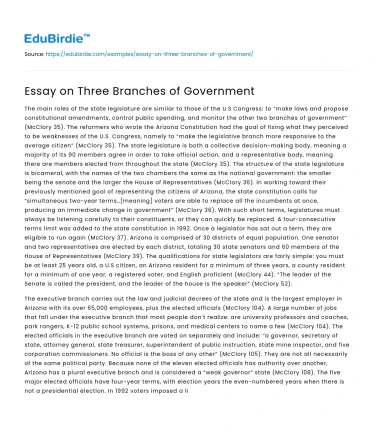The main roles of the state legislature are similar to those of the U.S Congress: to “make laws and propose constitutional amendments, control public spending, and monitor the other two branches of government” (McClory 35). The reformers who wrote the Arizona Constitution had the goal of fixing what they perceived to be weaknesses of the U.S. Congress, namely to “make the legislative branch more responsive to the average citizen” (McClory 35). The state legislature is both a collective decision-making body, meaning a majority of its 90 members agree in order to take official action, and a representative body, meaning there are members elected from throughout the state (McClory 35). The structure of the state legislature is bicameral, with the names of the two chambers the same as the national government: the smaller being the senate and the larger the House of Representatives (McClory 36). In working toward their previously mentioned goal of representing the citizens of Arizona, the state constitution calls for “simultaneous two-year terms…[meaning] voters are able to replace all the incumbents at once, producing an immediate change in government” (McClory 36). With such short terms, legislatures must always be listening carefully to their constituents, or they can quickly be replaced. A four-consecutive terms limit was added to the state constitution in 1992. Once a legislator has sat out a term, they are eligible to run again (McClory 37). Arizona is comprised of 30 districts of equal population. One senator and two representatives are elected by each district, totaling 30 state senators and 60 members of the House of Representatives (McClory 39). The qualifications for state legislators are fairly simple: you must be at least 25 years old, a U.S citizen, an Arizona resident for a minimum of three years, a county resident for a minimum of one year, a registered voter, and English proficient (McClory 44). “The leader of the Senate is called the president, and the leader of the house is the speaker” (McClory 52).
The executive branch carries out the law and judicial decrees of the state and is the largest employer in Arizona with its over 65,000 employees, plus the elected officials (McClory 104). A large number of jobs that fall under the executive branch that most people don’t realize: are university professors and coaches, park rangers, K-12 public school systems, prisons, and medical centers to name a few (McClory 104). The elected officials in the executive branch are voted on separately and include: “a governor, secretary of state, attorney general, state treasurer, superintendent of public instruction, state mine inspector, and five corporation commissioners. No official is the boss of any other” (McClory 105). They are not all necessarily of the same political party. Because none of the eleven elected officials has authority over another, Arizona has a plural executive branch and is considered a “weak governor” state (McClory 108). The five major elected officials have four-year terms, with election years the even-numbered years when there is not a presidential election. In 1992 voters imposed a limit of two consecutive terms for these five elected officials (McClory 110). The secretary of state is behind the governor in terms of succession (McClory 115). The governor is largely assumed to be the most powerful person in the state, but due to the plural executive branch, this is not always the case. “The governor’s primary job is to manage the state’s bureaucracy and coordinate the many executive-branch responsibilities” (McClory 117).
Save your time!
We can take care of your essay
- Proper editing and formatting
- Free revision, title page, and bibliography
- Flexible prices and money-back guarantee
“The judicial branch is the least visible of Arizona’s three branches of government. Judges actively promote anonymity by striving to remain ‘above politics. Nonetheless, the courts wield considerable power over public policy as well as the lives of private citizens” (McClory 135). There are five major courts in Arizona’s judicial system. Starting from the bottom, they are Justice of the Peace Court, Municipal Court, Superior Court, Arizona Court of Appeals, and Arizona Supreme Court. Justice of the Peace Courts are in all counties and deal with non-injury traffic cases and minor criminal cases. These judges are not required to have even a high school diploma. Municipal courts are in cities and towns and have traffic violations and minor crimes cases that occur within their city limits handled by judges who are mostly licensed, attorneys. Arizona’s Superior Court has a division in every county that handles trials for serious criminal and civil cases. Here there are formal, often long trials, frequently with twelve-person juries. These judges must have five years of experience as licensed attorneys, be at least 30 years old, and can be elected for an unlimited number of four-year terms. The Arizona Court of Appeals handles appeals presided over by three judges to see if mistakes were made in the original proceedings without any new evidence. The Arizona Supreme Court has five justices who oversee the lower courts and proceed over cases with statewide importance. They must also review all cases with the death penalty (McClory 140-146).






 Stuck on your essay?
Stuck on your essay?

